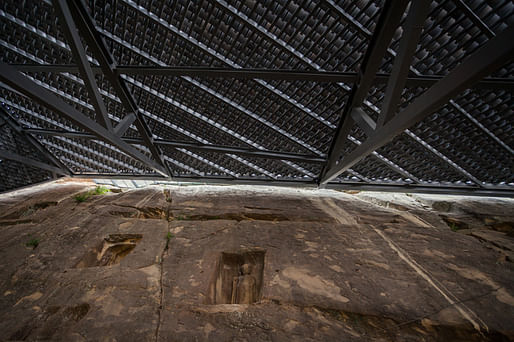
Designing a structure to protect a historic artifact or monument from the elements can often be a dry affair. At their most basic, such structures are often simple tent canopies, or more permanent, but still bare-bone, envelopes. Not the Qianfoya Cliff Inscriptions in Guangyuan, Sichuan Province, however. Rather, Cultural Heritage Protection Center at the Architectural Design and Research Institute of Tsinghua University crafted a unique structure to protect the 23 caves and niches containing inscriptions from the North Wei Dynasty, some 1700 years ago.
The project description details that the local climatological conditions—lots of rain, strong winds, and a fair amount of sunshine—all are to the disadvantage of conservation. So, first and foremost, the team collected a large amount of data, which was used to create, essentially, the design brief. In other words, the architecture had to protect the inscriptions from water, decrease the velocity of passing winds, and reduce temperature fluctuation by blocking sunlight. At the same time, they had to keep the cliff intact and maintain the original temperature and humidity of both the interior and exterior of the cliff and caves. The team also strived to “coordinate the architecture with its landscape environment”, as well as the local architectural vernacular.



The resulting structure comprises a semi-transparent “fabric” of tiles, both breathable and sheltering. In the process, a semi-outdoor space was created that ensures the full ventilation of air—at a proper speed—inside the structure. This solves a problem created by traditional structures that would trap heat and moisture. The gray tiles are sourced from the local area, where they are a common building material. The structure is anchored to a platform that cantilevers off of the cliff, supported by 18m deep manually-excavated piles. The structure also features an information display on a multimedia box.
“This project is the first attempt to provide a solution for protecting cliff inscriptions by adopting a comprehensive method of modern architecture and its technologies in the professional field of conservation in China, which is most challenging,” claim the architects.




More images and project diagrams in the gallery below.
No Comments
Block this user
Are you sure you want to block this user and hide all related comments throughout the site?
Archinect
This is your first comment on Archinect. Your comment will be visible once approved.